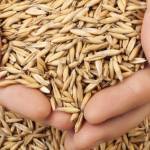Oats: A Popular Ingredient in Horse Feeds

Because the average oat grain is about 30% hull (fiber), and oats contain sufficient protein, calcium, and phosphorus to meet the requirements of mature horses, oats have traditionally been the predominant grain used by horsemen. Horses digest oats easily in comparison with heavier whole grains like wheat and corn.
Around the middle of the last century, more oats were grown in the U.S. than at present. The decline has been mainly due to poor yields. Genetic modification to improve yields has not been as successful in oats compared to gains in other crops. In spite of poor yields, the quality of oats cannot be denied.
Oat hulls are relatively low in energy and nutritive value. The majority of the protein is found in the groat. Protein content of oats averages around 12%, varying from 11.5% to 24%. Lysine is usually low, ranging from 3.2% to 5.2%. This points out one of the precautions that must be taken when formulating a ration with oats, as nutrient composition varies greatly between strains and is quite susceptible to environmental factors. Another point to remember is that the lysine level in oats is not high enough to support growth in young horses.
Starch is the major carbohydrate in oats, averaging 52.8%. Starch level varies inversely with protein content. Carbohydrate is higher in rolled oats and oat groats than in whole oats. Oats for grinding and use in feed should have a test weight of 27 lb (12 kg)/bushel and a 5% maximum level of foreign material. The maximum level of heat damaged kernels is 3%. Color can range from soft yellow or buff through almost white to dark yellow or gray. No moldy, sour, or musty smell should exist.
Quality of oats usually relates to the deterioration or oxidation of the lipid. Lipid content is low in hulls and higher in groats, averaging 5 to 9% and varying widely with cultivars. Whole oats and intact groats can be stored successfully at 10% moisture and normal temperatures, though free fatty acids increase rapidly in ground oats at normal temperatures. The deterioration rate increases rapidly at storage temperatures of 85° F or above. Quality is determined by measuring the free fatty acid levels.








